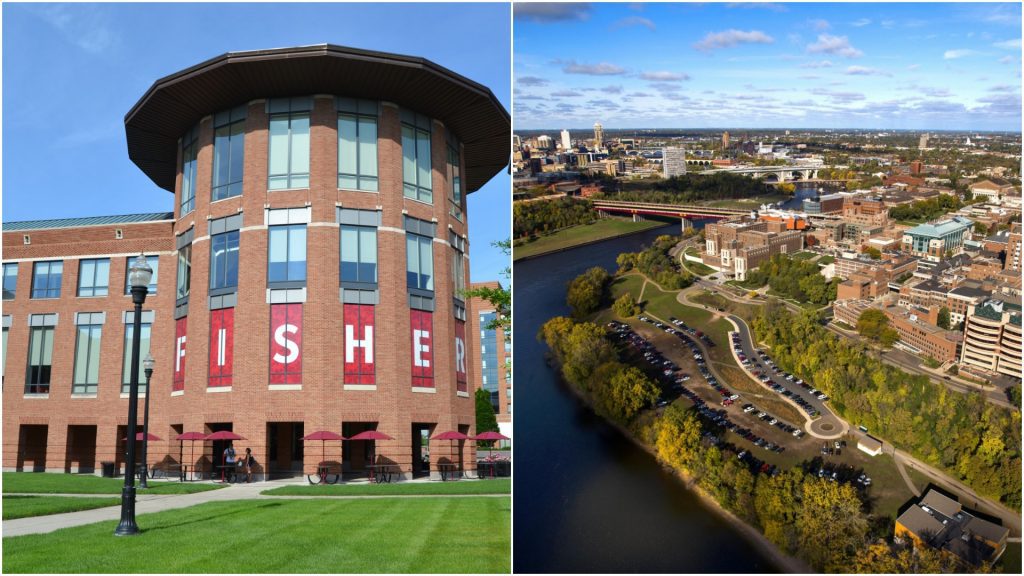School v. School: Ohio State Fisher vs. Minnesota Carlson

Narrowing down the options to pursue an MBA can be daunting, to say the least. Reputation, accessibility of alumni networks, rankings, and flexibility are just a few things to consider, not to mention location and cost. If you’ve already narrowed down a region in which you’d like to study and work, you’ve taken the first big step.
The Midwestern U.S. is rich with b-schools, and it is also home to a number of accounting, retail, utility, and agricultural firms that are always on the lookout for new talent. Following is a comparison of two schools in the region, Ohio State University Fisher College of Business and the University of Minnesota Carlson School of Management, which may be helpful as you hone in on your destination schools.
Ohio State vs Minnesota: Location
As Midwestern cities go, both Columbus, Ohio, and Minneapolis, Minnesota have strong overall appeal. Both cities are just about an hour’s flight from Chicago, but both have strong reputations as cultural centers themselves. Here is a look at some of the other factors that may determine which city is best for you.
- Cost of Living: The cost of living in Minneapolis 28 percent higher than that in Columbus.
- Housing: Minneapolis’ median housing price is 61 percent higher that Columbus’.
- Median Age of Residents: Residents of both cities are an average age of 32-years old.
- Median Income: Minneapolis residents make $56,000 annually, while those in Columbus make $49,000.
- Jobs: Columbus’ rate of unemployment is 1.3 percent higher than Minneapolis’.

The cost of living in Minneapolis is higher than Columbus, but Carlson grads, on average, earn higher salaries.
Ohio State vs Minnesota: Rankings
University of Minnesota Carlson School of Management
• U.S. News & World Report: 35
• Bloomberg: 29
• Forbes: 27
• Financial Times: 42 in the U.S.; 81 Global
• The Economist: 25 in the U.S.; 32 Global
Ohio State Fisher College of Business
• U.S. News & World Report: 31, 11 among public universities
• Financial Times: 84, 37 in the U.S., 20 among public universities
• Forbes: 46 overall, 23 among public universities
• The Economist: 55 overall, 45 in the U.S., 18 among public universities
Ohio State vs Minnesota: Cost
At Fisher, tuition for in-state residents, inclusive of fees, is $31,139. For those out of state, it is $53,642. At Carlson, full-time tuition for Minnesota, Wisconsin, North Dakota, South Dakota, and Manitoba residents is even more affordable at $20,060 per year. For non-residents it is $33,280 per year. There is a student services fee of $1,000 per year and a technology fee $1,200 per year.
Ohio State vs Minnesota: Post-graduate Employment
Fisher MBAs make an average starting salary of $97,626 and an average signing bonus of $21,360. Ninety-six percent of U.S. citizens and 90 percent of international students have job offers three months after graduation. The top five industries for Fisher MBAs are consulting, consumer products, financial services, healthcare, and manufacturing.

Upwards of 96 percent of U.S. citizens and 90 percent of international students have job offers three months after graduating from Ohio State’s Fisher College of Business.
The mean base salary for Carlson grads is $113,000 and a signing bonus of $25,192. About 80 percent of MBAs receive job offers three months after graduation, and 95 percent did so six months after graduation. The top five fields for Carlson MBA grads are marketing/sales, consulting, finance/accounting, general management, and operations/logistics.
Inside Ohio State Fisher
Fisher’s recently redesigned curriculum features skills assessments, personalized curriculum, and coaching based upon each student’s focus. The program incorporates immersive, cross-functional projects for top companies and organizations locally and globally. Unique program elements such as the Global Applied Projects, Business Lab Project and the Core Capstone Experience provide MBA students with numerous opportunities that will lead them into a successful career.
A total of 25.5 credit hours are integrated core coursework, 7.5 credit hours are comprised of experiential learning (Business Lab Project, Social Impact Challenge, Optional Global Applied Project), and 27 credit hours are elective coursework. The program requires a minimum of 60 credit hours to graduate.
Along with the full-time MBA, Fisher also offers a Working Professionals MBA and an Executive MBA.
Inside Minnesota Carlson
Carlson’s program is non-traditional in that it begins in the summer with online courses. In their first year, students take 25 of the 64 required credits in core courses, and they can then choose from over 70 electives. Experiential courses make up the second year, at which point students are offered global experience in one of three ways: a semester abroad; a two-week global “enrichment;” or a global course. The length of the commitment for the global experience can be counted for as little as four credits, or as much as 10.
Part-time, Online, and Executive MBAs are also available at Carlson along with the full-time MBA degree.
